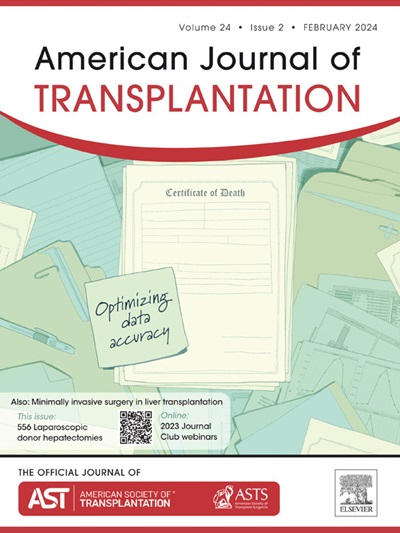重复hla错配对肾移植存活的影响:当代合作移植研究(cts)分析。
IF 8.2
2区 医学
Q1 SURGERY
引用次数: 0
摘要
重复HLA错配(RMM)历来与重复肾移植后移植物丢失的风险增加有关,特别是敏感受体的HLA- dr RMM。由于目前常规使用的敏感检测方法可以阻止RMM在宿主体内移植供体特异性抗体,我们假设RMM将不再与移植物损失相关。我们对协作移植研究数据库进行了注册分析,包括6711名在2010年至2021年间接受第二次肾移植(2nd KT)的患者,至少有一个HLA-A, -B或-DR不匹配。无论致敏状态如何,伴有I级RMM的第2 KT患者移植物丢失的风险均未增加。对于HLA-DR RMM的第2 KT,移植后第一年移植物丢失的危险比为1.61 (95% CI 1.16 - 2.23;P=0.004),在致敏受体(最新CDC-PRA> %)中增加到2.21 (95% CI 1.24 - 3.63: P=0.002)。我们的观察结果表明,I类RMM不需要系统地避免。相比之下,尽管Luminex广泛使用,HLA-DR RMM仍然对移植物存活有负面影响。本文章由计算机程序翻译,如有差异,请以英文原文为准。
Impact of repeat human leukocyte antigen mismatches on kidney graft survival: A contemporary Collaborative Transplant Study analysis
Repeat human leukocyte antigen (HLA) mismatches (RMM) have been historically associated with an increased risk of graft loss after repeat kidney transplantation, in particular HLA-DR RMM in sensitized recipients. As routine use of sensitive assays can at present prevent the transplantation of RMM in hosts with donor-specific antibodies, we hypothesized that RMM would no longer be associated with graft loss. We performed a registry analysis of the Collaborative Transplant Study database including 6711 patients who received a second kidney transplant (KT) between 2010 and 2021, with at least 1 HLA-A, HLA-B, or HLA-DR mismatch. No increased risk for graft loss was observed for the second KT with a class I RMM, regardless of sensitization status. For the second KT with a HLA-DR RMM, the hazard ratio for graft loss in the first year after transplantation was 1.61 (95% CI 1.16-2.23; P = .004) compared to recipients without an RMM and increased to 2.21 (95% CI 1.24-3.63: P = .002) in sensitized recipients (latest complement-dependent cytotoxicity panel reactive antibodies >0%). Our observations suggest that class I RMM do not need to be systematically avoided. In contrast, HLA-DR RMM still had a negative impact on graft survival in this contemporary cohort, despite the widespread availability of Luminex.
求助全文
通过发布文献求助,成功后即可免费获取论文全文。
去求助
来源期刊
CiteScore
18.70
自引率
4.50%
发文量
346
审稿时长
26 days
期刊介绍:
The American Journal of Transplantation is a leading journal in the field of transplantation. It serves as a forum for debate and reassessment, an agent of change, and a major platform for promoting understanding, improving results, and advancing science. Published monthly, it provides an essential resource for researchers and clinicians worldwide.
The journal publishes original articles, case reports, invited reviews, letters to the editor, critical reviews, news features, consensus documents, and guidelines over 12 issues a year. It covers all major subject areas in transplantation, including thoracic (heart, lung), abdominal (kidney, liver, pancreas, islets), tissue and stem cell transplantation, organ and tissue donation and preservation, tissue injury, repair, inflammation, and aging, histocompatibility, drugs and pharmacology, graft survival, and prevention of graft dysfunction and failure. It also explores ethical and social issues in the field.

 求助内容:
求助内容: 应助结果提醒方式:
应助结果提醒方式:


